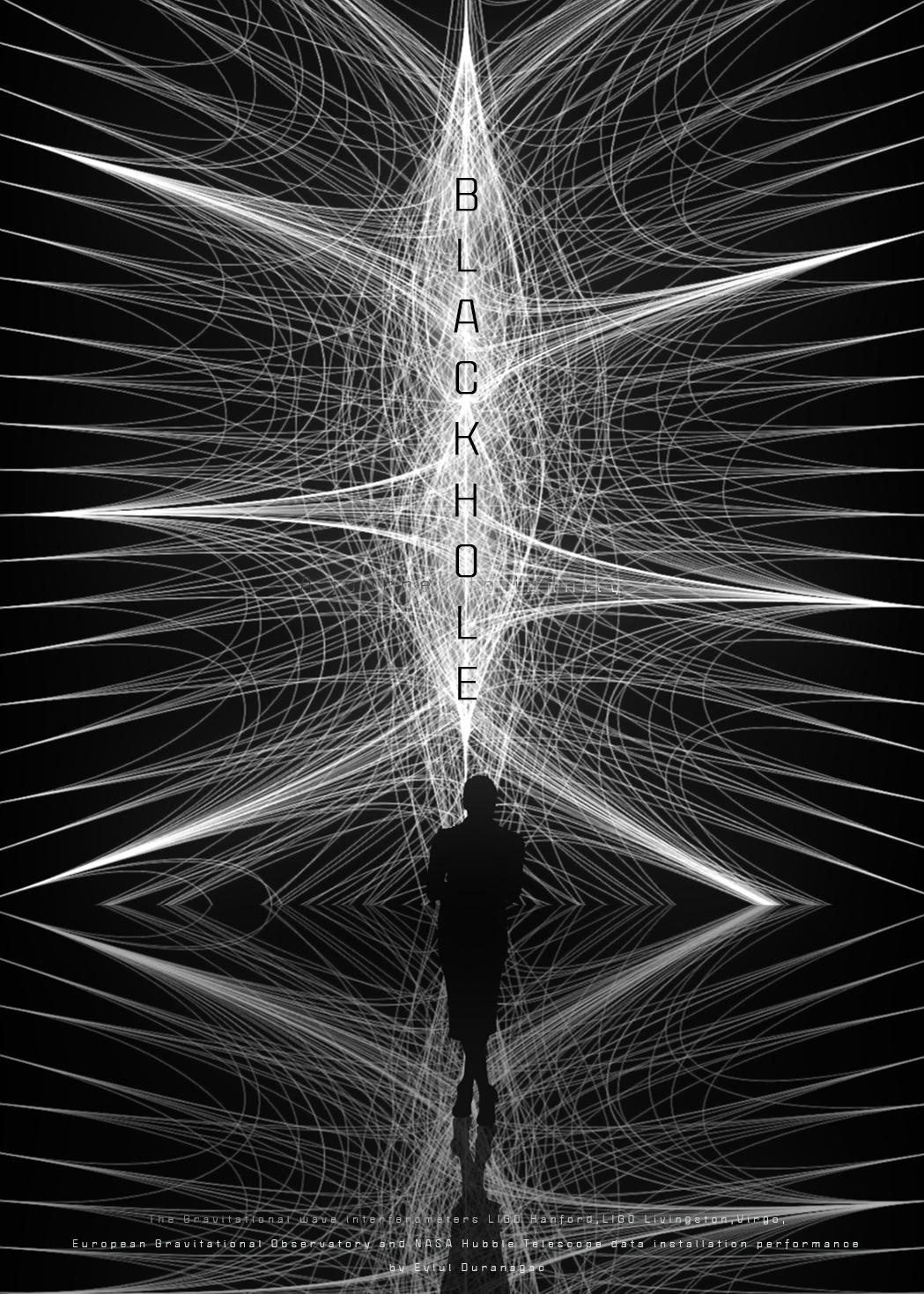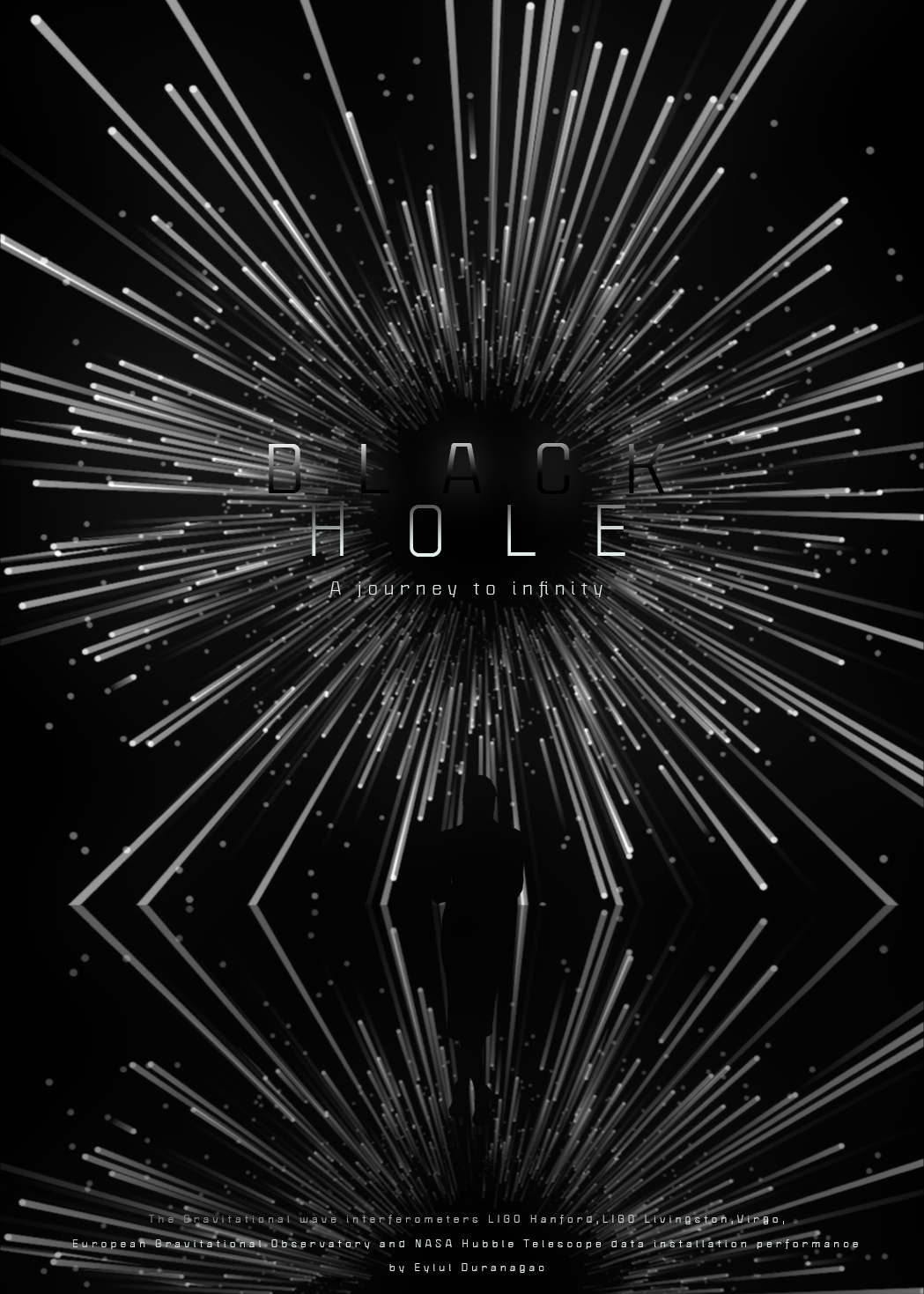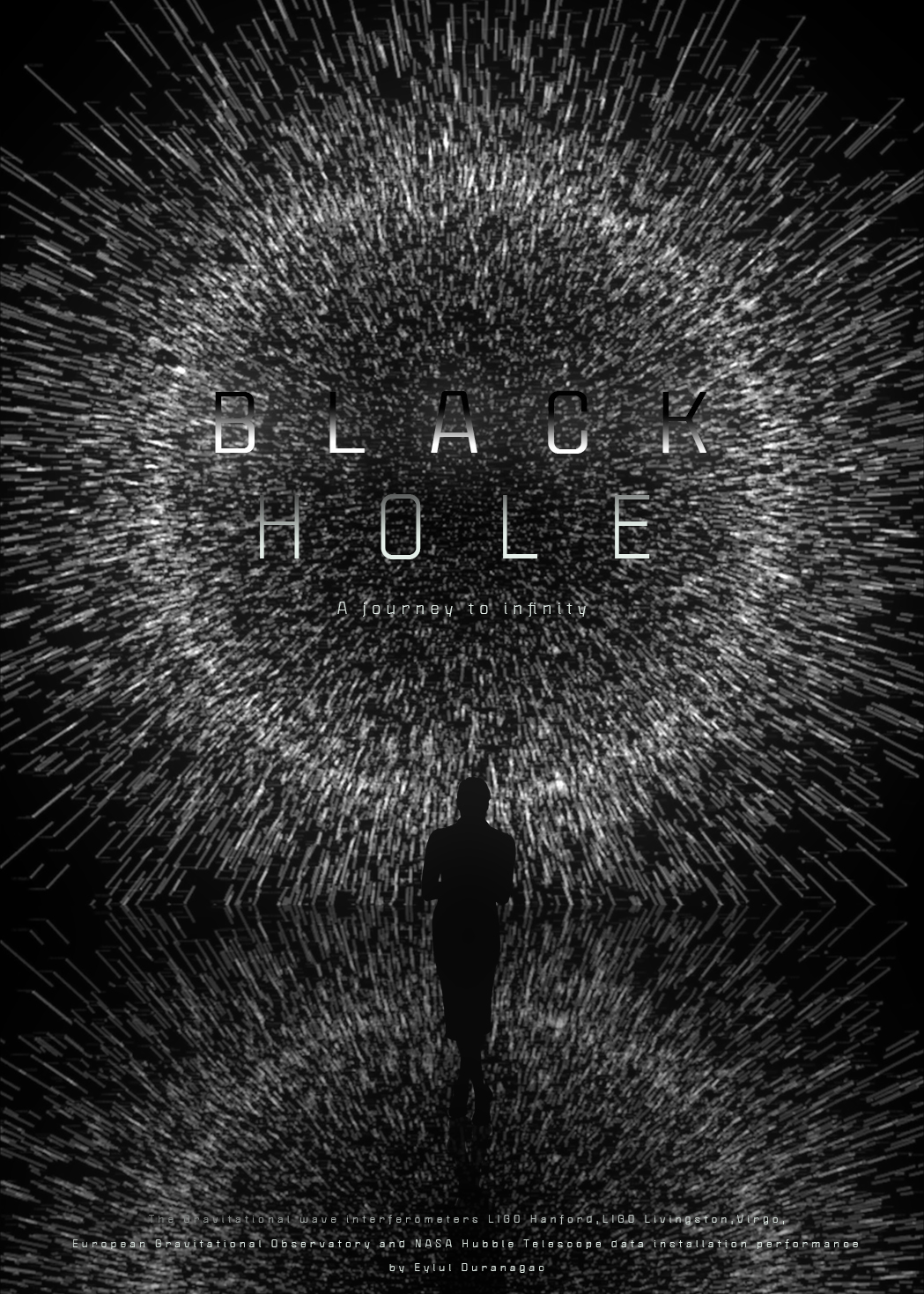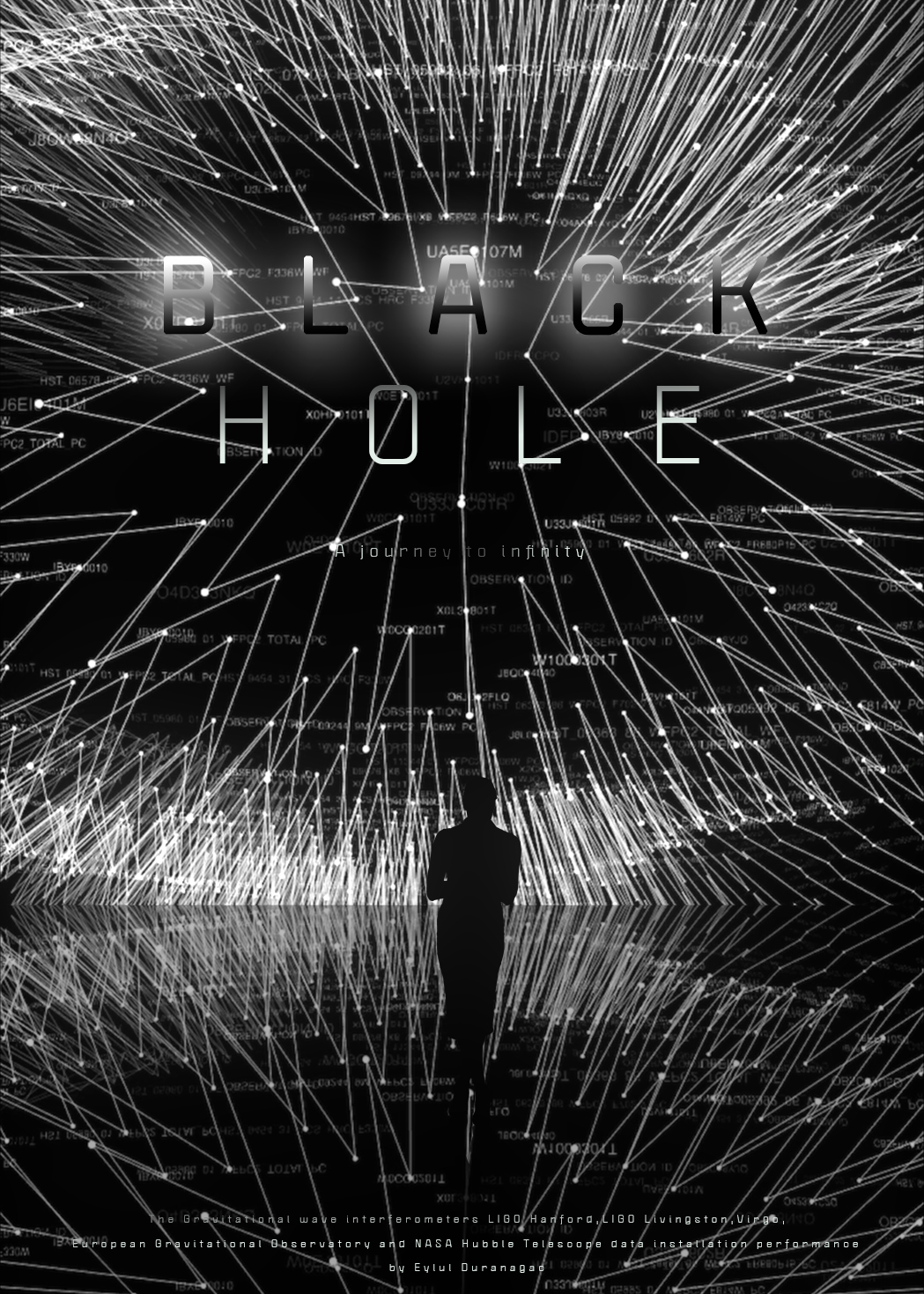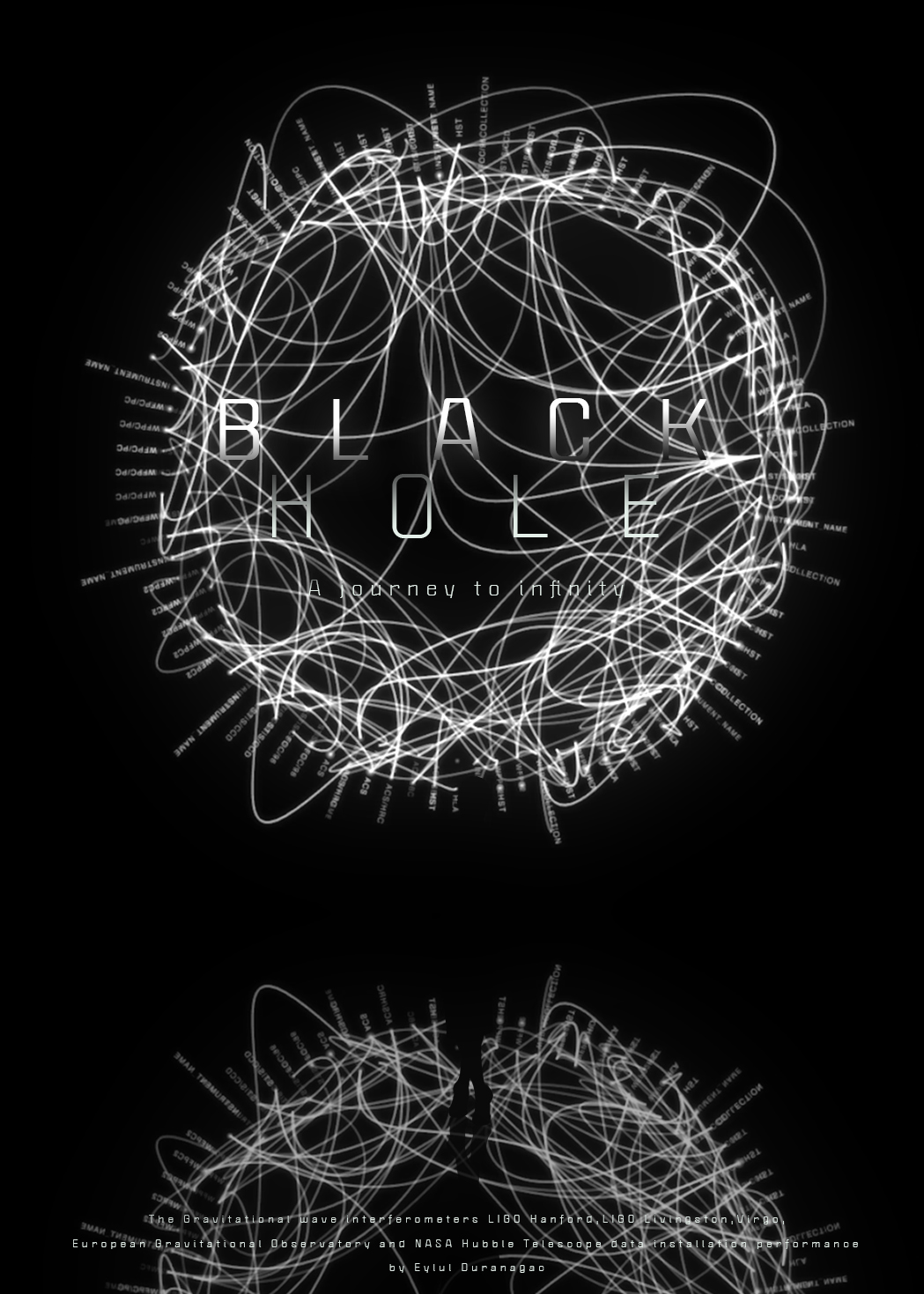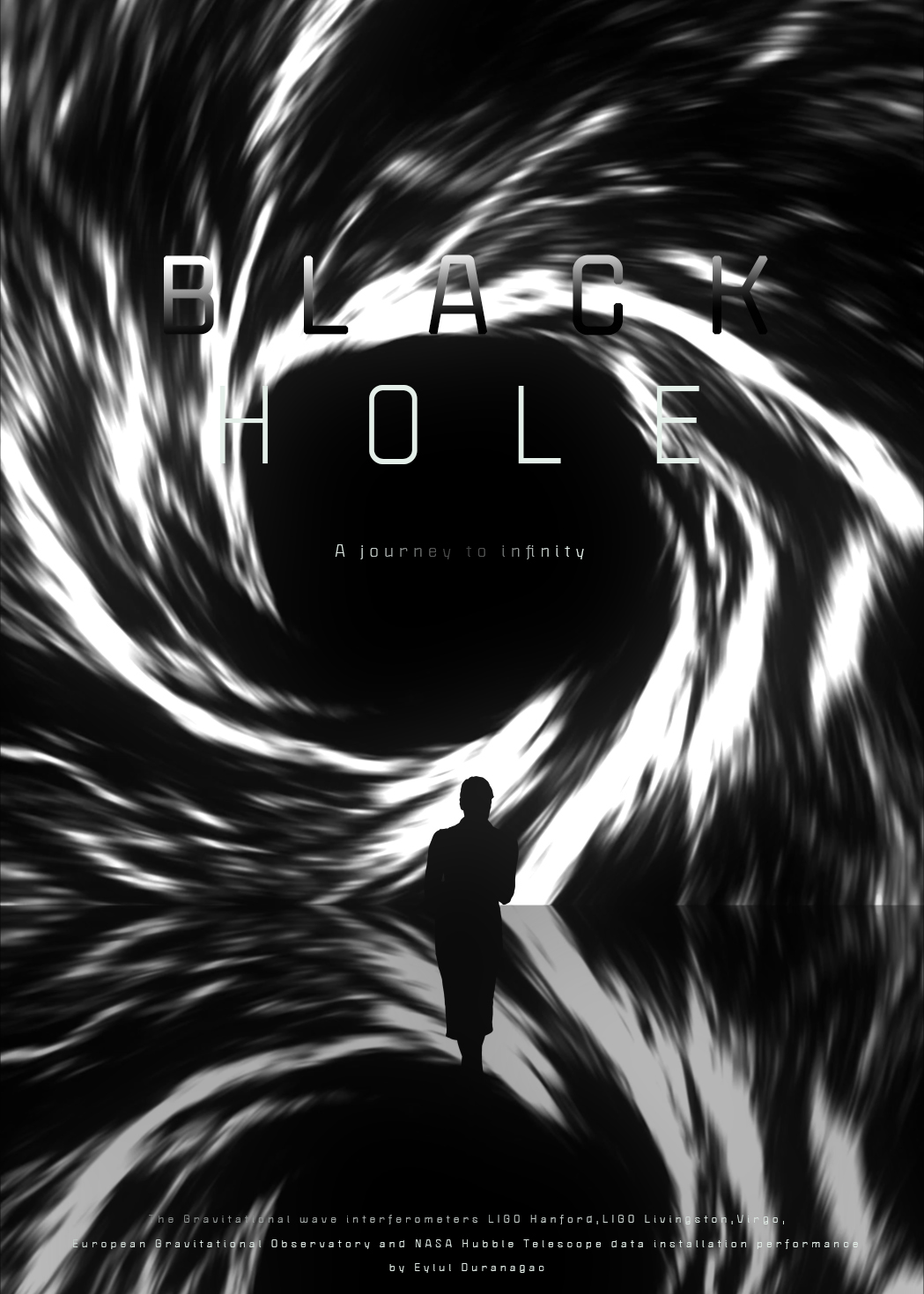The dataset of the artwork, I used over 73.000 special data collection which includes the exact form of a binary black hole waveform are the masses, sky location, distance, black hole spins, binary orientation angle, gravitational wave polarization, time of arrival, and phase at coalescence (merger).
In this collection, GW signals from binary black hole merging are specifically visualized as a model for analyzing simulated GW time series data from a network of Earth-based detectors. By using the NASA Hubble Legacy Archive, European Gravitational Observatory, Gravitational wave interferometers LIGO Hanford, LIGO Livingston, Virgo open-source data set, you will be observing the inky blackness of a giant black hole, meteors, and see what's on the other side of that enigmatic event horizon as a heterotopic mirror.
‘’This couldn't be truer for the breakthrough discovery of gravitational waves (GW), signals from colliding binary black holes in 2015 .GW signals have led researchers to observe a new population of massive, stellar-origin black holes, to unlock the mysteries of neutron star mergers, and to measure the expansion of the Universe. ‘’(European Gravitational Observatory)
In this collection, GW signals from binary black hole merging are specifically visualized as a model for analyzing simulated GW time series data from a network of Earth-based detectors. By using the NASA Hubble Legacy Archive, European Gravitational Observatory, Gravitational wave interferometers LIGO Hanford, LIGO Livingston, Virgo open-source data set, you will be observing the inky blackness of a giant black hole, meteors, and see what's on the other side of that enigmatic event horizon as a heterotopic mirror.
‘’This couldn't be truer for the breakthrough discovery of gravitational waves (GW), signals from colliding binary black holes in 2015 .GW signals have led researchers to observe a new population of massive, stellar-origin black holes, to unlock the mysteries of neutron star mergers, and to measure the expansion of the Universe. ‘’(European Gravitational Observatory)
GRAVITATIONAL WAVE INTERFEROMETERS__(LIGO Hanford, LIGO Livingston, and Virgo)
The theory of general relativity shows us that a pair of black holes in orbit around each other loses energy in the form of gravitational waves (GWs).The two black holes approach each other, a phenomenon that can last for billions of years, before accelerating suddenly in what is called compact binary coalescence. In a fraction of a second, the two black holes then collide at a speed close to that of light and merge into a single black hole. As this one is lighter than the sum of the two initial black holes, a part of their mass (the equivalent of three Suns in the case of the detection called GW150914) is converted into GWs according to Einstein’s formula 𝐸=𝑚𝑐2 . It is these GWs that LIGO and VIRGO may have observed.
Virgo Interferometer
The Virgo interferometer is a large interferometer designed to detect gravitational waves predicted by the general theory of relativity. Virgo is a Michelson interferometer that is isolated from external disturbances: its mirrors and instrumentation are suspended and its laser beam operates in a vacuum. The instrument's two arms are three kilometres long and located in Santo Stefano a Macerata, near the city of Pisa, Italy.
Ligo Interferometer
The Laser Interferometer Gravitational-Wave Observatory (LIGO) is a large-scale physics experiment and observatory designed to detect cosmic gravitational waves and to develop gravitational-wave observations as an astronomical tool.[1] Two large observatories were built in the United States with the aim of detecting gravitational waves by laser interferometry. These observatories use mirrors spaced four kilometers apart which are capable of detecting a change of less than one ten-thousandth the charge diameter of a proton.
The Virgo interferometer is a large interferometer designed to detect gravitational waves predicted by the general theory of relativity. Virgo is a Michelson interferometer that is isolated from external disturbances: its mirrors and instrumentation are suspended and its laser beam operates in a vacuum. The instrument's two arms are three kilometres long and located in Santo Stefano a Macerata, near the city of Pisa, Italy.
Ligo Interferometer
The Laser Interferometer Gravitational-Wave Observatory (LIGO) is a large-scale physics experiment and observatory designed to detect cosmic gravitational waves and to develop gravitational-wave observations as an astronomical tool.[1] Two large observatories were built in the United States with the aim of detecting gravitational waves by laser interferometry. These observatories use mirrors spaced four kilometers apart which are capable of detecting a change of less than one ten-thousandth the charge diameter of a proton.
Gravitational Waves Detected for the First Time
A century ago, Albert Einstein theorized that when objects move through space they create waves in spacetime around them. These gravitational waves move outward, like ripples from a stone moving across the surface of a pond. Little did he know that 1.3 billion years earlier, two massive black holes collided. The collision released massive amounts of energy in a fraction of a second (about 50 times as luminous as all the stars in the visible universe combined) and sent gravitational waves in all directions. On September 14, 2015 those waves reached Earth and were detected by researchers at the Laser Interferometer Gravitational-Wave Observatory (LIGO).
PROCESS
A training set of time series data containing simulated gravitational wave measurements from a network of 3 gravitational wave interferometers (LIGO Hanford, LIGO Livingston, and Virgo). Each time series contains either detector noise or detector noise plus a simulated gravitational wave signal.
The collection in Black Hole is inspired by the journey of infinity of tens of thousands of light years beyond the solar system.for the installation to renew itself over millions of data, including gravitational wave interferometers LIGO Hanford, LIGO Livingston, Virgo and Hubble Telescope. In the dataset of the artwork, I collected generated from there are over 73.000 data which include to the exact form of a binary black hole waveform are the masses, sky location, distance, black hole spins, binary orientation angle, gravitational wave polarization,, time of arrival, and phase at coalescence (merger).
These parameters (15 in total) have been randomized according to astrophysically motivated prior distributions and used to generate the simulated signals present. As I shared on a subpage(Pages 29-36), you can see the visualization of specific datasets include to the instrument name collection, observation id, target id, ra deg, end time. Also, I used to generate from the footprint of the observation STC string format data.
Source; A training set of time series data containing simulated gravitational wave measurements from a network of 3 gravitational wave interferometers (LIGO Hanford, LIGO Livingston, and Virgo). Each time series contains either detector noise or detector noise plus a simulated gravitational wave signal.
The collection in Black Hole is inspired by the journey of infinity of tens of thousands of light years beyond the solar system.for the installation to renew itself over millions of data, including gravitational wave interferometers LIGO Hanford, LIGO Livingston, Virgo and Hubble Telescope. In the dataset of the artwork, I collected generated from there are over 73.000 data which include to the exact form of a binary black hole waveform are the masses, sky location, distance, black hole spins, binary orientation angle, gravitational wave polarization,, time of arrival, and phase at coalescence (merger).
These parameters (15 in total) have been randomized according to astrophysically motivated prior distributions and used to generate the simulated signals present. As I shared on a subpage(Pages 29-36), you can see the visualization of specific datasets include to the instrument name collection, observation id, target id, ra deg, end time. Also, I used to generate from the footprint of the observation STC string format data.
https://www.ligo.caltech.edu/news/ligo20160211
https://en.wikipedia.org/wiki/LIGO
https://en.wikipedia.org/wiki/VIRGO
_Cleaned data was analyzed and explored visually_
![]()

_Black Hole_Gravitational Wave_ Special Edition Data Visualization Collection_
_
Poster Series_

